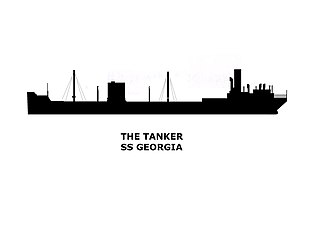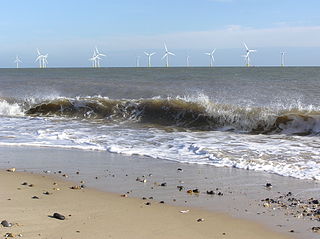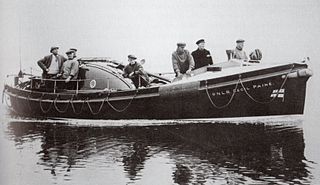
The SS English Trader was a British merchant ship wrecked off the coast of Norfolk, England in October 1941. After falling behind a convoy during the Second World War of which she was a part, the ship ran aground on the Hammond's Knoll sandbank and began to break up during a gale. Several rescue attempts by lifeboats failed, but a further attempt the following day by the Cromer Lifeboat rescued 44 of the crew, three having already been lost.

The SS Mount Ida was a cargo ship built in 1938 by William Hamilton & Co. Ltd of Glasgow. Launched in 1938 as Arcscott, she was renamed Mount Ida after being bought by the Atlanticos Steam Ship Company Ltd, of Athens, Greece. She was wrecked in 1939 after being in service for only about 18 months.

SS Georgia was an oil tanker that was built in the United States in 1908 as Texas and spent most of her career in the United States Merchant Marine. In 1917 she was renamed Georgia. In 1927 she was transferred to Dutch ownership, and shortly thereafter ran aground and was lost on Haisborough Sands off the coast of Norfolk, England.

Henry "Shrimp" Thomas Davies BEM was a lifeboatman from Cromer on the north coast of Norfolk, England. His uncle, Henry Blogg, gave him the nickname "Shrimp" after seeing him as a tiny baby. In 1931 he joined the crew of the Cromer lifeboat H F Bailey and became coxswain in 1947, taking over from Henry Blogg. Davies retired in February 1976, after serving as coxswain of lifeboats Henry Blogg and Ruby and Arthur Reed, having been one of Cromer Lifeboat Station's longest serving coxswains.

RNLB Henry Blogg was the eighteenth lifeboat to be stationed at Cromer in the county of Norfolk.

Great Yarmouth and Gorleston lifeboat station is a RNLI base in Norfolk, England. There were originally two separate stations at Great Yarmouth and Gorleston – two coastal towns either side of the River Yare. These were merged in 1926.

SS Monte Nevoso was a cargo steamship that was launched in 1920 in England, owned in Italy, and wrecked in 1932 in the North Sea off the coast of Norfolk.
The SB Hibernia was a 75-ton spritsail Thames barge built in Greenhithe, Kent in England in 1906, and which was wrecked on the North Sea coast at East Runton during the night of 9/10 November 1937. Her crew of three were rescued by the Cromer lifeboat.

SS Meriones was a Blue Funnel Line refrigerated cargo steamship. She was launched in 1921 on the River Tyne as one of a class of 11 ships to replace many of Blue Funnel's losses in the First World War.
SS Gallois was a French collier built in 1917 as Tynemouth and later Lord Aberconway. She was one of seven merchant vessels which became stranded and then wrecked on Haisbro Sands off the Norfolk coast on 6 August 1941 during the Second World War as part of Convoy FS 559.

Alf was a three-masted Norwegian barque which became stranded and then wrecked on 23 November 1909 on Haisbro Sands, off the coast of Norfolk. She was originally built in 1876 as Inchgreen for Scottish owners. In the 1890s she was sold to Danish owners and renamed Adolph Harboe. Around the turn of the 20th century she was sold to Norwegian owners and renamed Alf, serving until she was wrecked off the coast of Norfolk.

William George Fleming GC (1865–1954) was a lifeboatman from Gorleston-on-Sea on the east coast of Norfolk, England. His service with the Royal National Lifeboat Institution (RNLI) spanned nearly fifty years, in which time he won the George Cross and the RNLI Medal in Gold and in Silver, and the Bronze Medal three times.

Scroby Sands is a sandbank off the coast of Norfolk, England which runs near shore, north to south from Caister south towards Great Yarmouth. It has been the site of many shipwrecks. Scroby Sands Wind Farm, an offshore 60 MW wind farm, is situated on the sandbank and opened in 2003.

HM Trawler Agate was purchased by the Royal Navy in 1935. She was modified from a trawler to be used to carry out anti-submarine work. In 1941 she was with the maintenance reserve at Rosyth, but in August was part of the Royal Navy's escort flotilla with convoy FS559 when she ran aground, becoming a total loss, on Haisborough Sands on 6 August with a loss of sixteen crewmen.

RNLB Foresters Centenary is a retired Liverpool-class lifeboat of the Royal National Lifeboat Institution (RNLI), stationed in the English coastal town of Sheringham in the county of Norfolk in the United Kingdom. The lifeboat was on station for 25 years between 1936 and 1961 when she was sold. She has been restored to her original condition and is exhibited in Sheringham Museum.

RNLB Cecil Paine is a retired Liverpool-class non-self-righting lifeboat of the Royal National Lifeboat Institution. It was the second motor lifeboat to be stationed in the English coastal town of Wells-next-the-Sea in the county of Norfolk in the United Kingdom, and was on station at Wells from 25 July 1945 until she was sold in June 1965.

Lowestoft Lifeboat Station is a Royal National Lifeboat Institution (RNLI) operated lifeboat station in the town of Lowestoft in the English county of Suffolk. The station is located at the mouth of Lowestoft's outer harbour on the South pier. It is one of the oldest lifeboat stations in the United Kingdom, having been established in 1801.
Convoy FS 559, eventually comprising ten merchant ships, was a British convoy in World War II which departed Methil, Scotland on 4 August 1941, then Newcastle-upon-Tyne, for Southend, Essex. The protecting force comprised the destroyers HMS Vimiera and HMS Wolsey, supported by HMT Agate and HMT Arkwright. On the night of 6 August, six merchant ships from the convoy and escort Agate ran aground on the Haisborough Sands. The Cromer lifeboat H.F. Bailey was the first to arrive, and rescued 16 men from the SS Oxshott, 31 from the SS Gallois, 19 from the Deerwood and 22 from Betty Hindley. The Cromer second lifeboat Harriot Dixon and the Great Yarmouth and Gorleston lifeboat Louise Stephens between them rescued a further 31 men.

The SS Fernebo was a Swedish cargo ship that was built in 1912. She was wrecked off Cromer, Norfolk, in England on 9 January 1917, being split in two by a boiler explosion or a German sea mine. Her chief engineer was killed but the remaining 17 crew members were rescued by onlookers and the Cromer lifeboat, commanded by Henry Blogg. Part of her wreck remains on the beach at Cromer but is only visible at extremely low tides.

Caister Lifeboat Station is located in the village and seaside resort of Caister-on-Sea, on the east coast of the county of Norfolk.
















